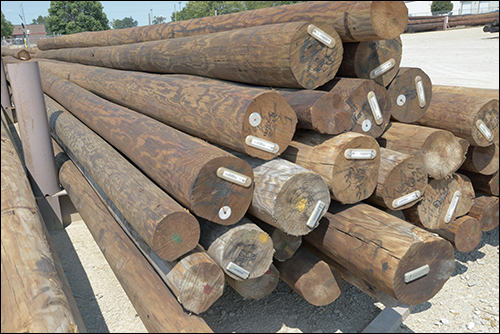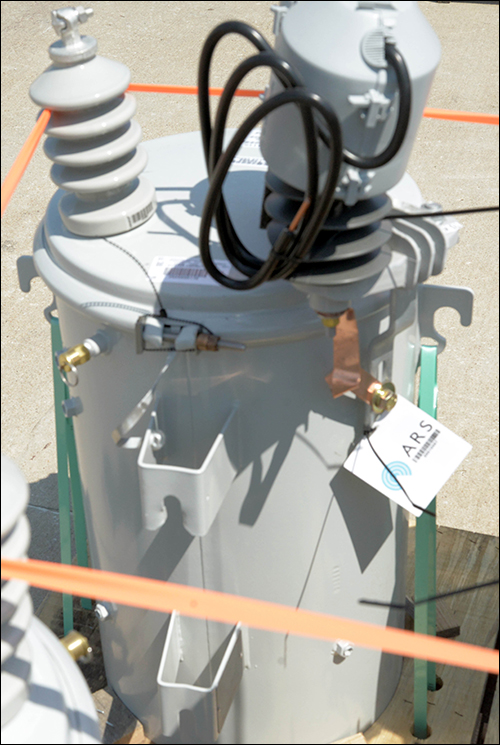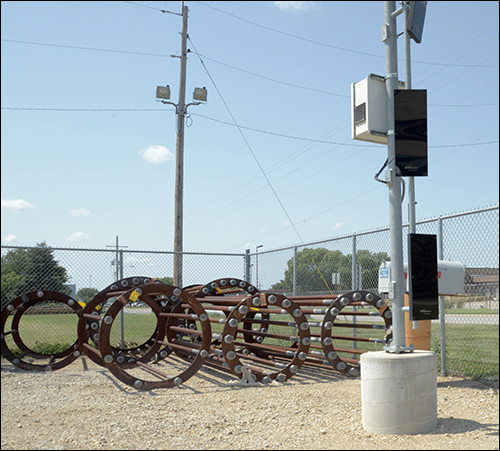For utility companies, the management of assets like wooden poles, transformers and wire is complex and labor-intensive. The movement of these large, high-value items can take place at all hours, often involving multiple employees and contractors. During storms and resulting clean-up work, the tracking of inventory can become even more challenging, but it’s also more important, since knowing how many of the items are on hand is critical to restoring power.
Westar Energy, in Kansas, has adopted an automated system that employs radio frequency identification technology to track its pole and transformer inventory. The company’s suppliers attach passive EPC Gen 2 ultrahigh-frequency (UHF) RFID tags to all poles and transformers that they ship to three storage yards, where RFID readers are installed at the gates. Contractors’ and Westar’s vehicles that come and go from the yards have passive EPC Gen 2 UHF RFID tags attached to them as well, so that Westar Energy knows who takes which pole or transformer, when this occurs and when any items are returned. This data, along with daily inventory counts conducted by means of a handheld reader in each yard, ensures that the firm knows what assets it has on hand at any given time, as well as when reordering is necessary. It also saves labor time that workers previously spent manually counting assets within each yard, or making phone calls trying to locate specific items.
Westar Energy is the largest electric utility provider in Kansas. The company delivers power to approximately 690,000 residential and business customers across 55 counties, and holds ownership of 13 power plants and wind farms. It maintains 6,300 miles of transmission lines and 28,000 miles of distribution lines. More than a decade ago, the firm looked into adopting an RFID solution to help track the movements of goods into and out of its laydown yards, but found that the technology was not yet mature enough to provide what it needed at an affordable price. About four years ago, says Rick Boswell, Westar Energy’s director of supply chain inventory and distribution, the company reexamined the technology and selected a system supplied by American RFID Solutions.
The solution was installed in 2013 at three storage yards: two for housing poles and transformers at distribution centers servicing the largest cities Westar serves (Topeka and Wichita), and a pole-collection yard located near a substation outside Wichita. Although the energy company must also track a variety of tools and materials, it opted to start with monitoring poles and transformers since they proved to be the most challenging for RFID technology. Hundreds of poles and transformers are stored at each site.
At any time of the day or night, workers may have to collect poles or transformers for repair work on power lines. Prior to the RFID system’s installation, Westar’s only process for tracking these assets was to have workers fill out a form as they left the yard, indicating who they were and what they took. If they returned something that wasn’t used, they had to fill out another form.
These forms brought their typical challenges of not always including complete, legible and accurate information, leading to uncertainty regarding what was in the yard. Performing inventory counts was a cumbersome, manual process that was done once a year, the company reports.
With the RFID system, Westar’s pole manufacturer applies XtremeRFID UHF tags customized for durability that are screwed to the end of each pole. The transformer manufacturer attaches Metalcraft rugged RFID tags with a zip tie so that the hangtags can transmit data to readers without interference from the metal transformer.
Westar carried out several months of tag durability testing in 2013, Boswell explains, in order to ensure that the tags, when attached to poles and transformers, could sustain the rigors of rail delivery and being moved and stacked on trucks. Employees applied different makes and models of tags to poles and transformers, and then transported them past the gate reader to identify the best types of tags, tag placement and location of reader antennas.
Several challenges arose during the installation, according to John Rommel, American RFID’s director of sales and marketing. The gate at one facility opened onto a street where other Westar-tagged trucks pass, so the company had to install the antennas in such a way that they would not read the tags of trucks that might be driving by but not entering that gate. This also required that the algorithms in the software be adjusted to ensure that stray reads were not captured. The hangtags on the transformers could be blown off in extreme wind, so American RFID modified the tags to include a metal grommet that would hold them in place.
Once the durability tests were concluded, American RFID installed FX9500 readers from Motorola Solutions (now part of Zebra Technologies) at each gate to all three facilities, with multiple antennas at each site in order to determine whether a vehicle was arriving or leaving.
Each truck has a standard off-the-shelf RFID tag attached to its windshield and encoded with a unique ID number linked to data related to that vehicle and, if applicable, the contractor. When an empty vehicle arrives at the gate, the readers capture the event and forward that information via wireless communication.
The truck is then loaded with the necessary poles and transformers. The driver still fills out the paper form for redundancy purposes, then drives the vehicle out the gate. The RFID system captures that event as well and determines what goods have been removed, as well as by what company and vehicle.
Westar personnel collect and process the paper forms completed by drivers. Each day, they compare inventory records from the company’s mainframe system and the RFID solution. If discrepancies are noted, Boswell says, a staff member walks through the yard with a Motorola (Zebra) MC3190-Z handheld reader, capturing each tag’s ID number, and thereby collecting an up-to-date inventory of those assets. With RFID, the company knows who took the equipment if something goes missing, and has a record of when it needs to reorder specific poles or transformers.
Boswell reports that the technology has reduced labor costs by making the yard staff’s work more efficient, and by ensuring that inventory counts are accurate. It also makes it easy to make sure that the stock of poles and transformers does not fall below a specific threshold at each site.
Since the RFID system was deployed for poles and transformers, Boswell says, “It’s been a tremendous help in keeping our inventory accurate.”





